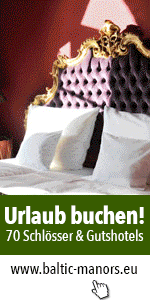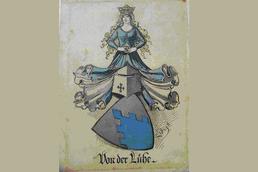The von der Lühe Family
According to legend the history of the von der Lühe family and the origin of the compound in Kölzow are connected to a love story that occurred over 800 years ago.
Two de Lu (today von der Lühe) brothers, both knights in the service of Henry the Lion, freed a Wendish princess from the burning fortress Ilow near Wismar, one of the main strongholds of the Wendish prince Niklot. Niklot surrendered his castles before withdrawing in the face of Henry the Lion's troops to his last fortress of Werle. Both brothers were enchanted by the beauty of the princess and wished to marry her. The princess, who was fond of them both, was to choose between them. To one brother she gave a bouquet, and to the other a gold circlet. This brother was the chosen husband.
A crowned princess has decorated the family arms ever since. The arms of the descendants of both brothers are identical, with one exception. On those of the descendants of the brother who married the princess, she holds a ring in her hands. On the arms of the other brother's descendants she holds a bouquet of flowers. Both branches of the family existed into the eighteenth century, when the line with the bouquet on its arms died out. Their arms are still to be found on many gravestones, memorial plaques, etc. Those family members bearing the name today have the ring on their arms. At the end of the twelfth century the ancestors of the family received the responsibility of recruiting settlers for eastern Mecklenburg from the domains of Henry the Lion. They chose Kölzow as the first settlement and built a fortress there: a moat with a defensive tower on the island, and finally the church, dedicated in 1233.
The fieldstone church of Kölzow is one of the oldest houses of worship in Mecklenburg-Vorpommern. The choir is the oldest section. Constructed with thick rock walls, it also served as a defensive tower. Only in 1987 were frescoes rediscovered in the church. They had been covered with whitewash in 1736 when a Baroque altar was installed in the choir. This altar was incompatible with the simple paintings, which were then obscured with whitewash. During renovations in 1987 they were rediscovered and uncovered. One of the frescoes illustrates the princess's selection of bridegroom and is thus probably the oldest depiction of members of the von der Lühe family. The beautiful organ by Master Friese III was dedicated on the fourth Sunday of Advent in 1833.
The first manor house lay in the immediate vicinity of the tower. Later the location of the house shifted about 100 meters to drier ground. The Kölzow estate remained in the possession of the von der Lühe family until the end of the eighteenth century. The current house was built in 1850 on the site of an older structure by members of the von Prollius family, then the owners of Kölzow. In 1925 Prince Sigismund of Prussia bought the house and estate as a summer residence, and his family remained in possession until 1945. After 1945 the house was used as accommodation for refugees, and later it housed both the village cooperative store and the kindergarten. In 2000 the von der Lühe family acquired the house and park, with renovations beginning in fall 2001. Since May 2004 the manor house has received guests as the Country House Schloss Kölzow. The gable of the house is decorated with a female head in relief. It is meant to recall the family's ancestress.
Further information: www.schloss-koelzow.de
Güter:
|
Böhlendorf |
Groß Vielen |
Rakow, Neubukow |


